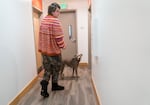
Marcieline Novatore, center, and her partner Eloise Zana, with their dog “Bow,” in their Northwest Portland home, Jan. 22, 2024. Novatore and Zana, both in their mid-20s, each experienced homlessness in Portland. Oregon has the highest rate of unaccompanied, unsheltered youth in the nation.
Kristyna Wentz-Graff / OPB
This is Part 1 in series of stories looking at Oregon’s unsheltered young adults — learning who they are and what forces are working against them. See Part 2 and Part 3.
Eloise Zana and Marcieline Novatore, both in their mid-20s, are partners who lean on each other through difficult times. They’ve both endured being homeless in Portland. But to get through that traumatic experience, they also leaned on the community they found.
Oregon has the highest rate of unaccompanied, unsheltered youth in the nation. Meanwhile, the support systems for people experiencing homelessness are underfunded and often neglect the unique needs of people living on the streets who are barely out of high school. Without family or trusted adults to turn to, young people experiencing homelessness in Oregon are learning it’s up to them to take care of themselves.
Novatore is a prolific visual and sound artist. Much of her work is a commentary on her life experience as an Indigenous, transgender woman.
“These are all abstract paintings,” said Novatore at a recent art exhibit she curated that showcased her own work as well as pieces from her friends. “I do them when I’m feeling dysphoric, or something about the world is [messing] me up in the head.”

“We are trapped inside this machine,” a show of work, curated and created by Marcieline Novatore at p:ear, Dec. 7, 2023. The program serves youth ages 15-24 who are experiencing homelessness. Novatore’s visual and sound work draws on her life experience as an Indigenous, transgender woman.
Kristyna Wentz-Graff / OPB
Zana also creates art, and rarely leaves home without a knitting project. This winter, Zana has been knitting a rainbow-colored cable-knit sweater for a friend.
“If it doesn’t end up fitting them, I have more yarn in this color and I’m gonna give this sweater to someone who needs it,” said Zana.
Zana and Novatore’s community of friends and found family is one with great needs, the most important of which is stable and safe housing. They are part of Oregon’s homeless youth community, a group of young adults ranging from 18-24 years old. And though both Zana and Novatore have been housed for more than a year, this is still the community they fall back on.
“We take care of us,” said Zana. “That’s a big saying in the community: ‘We take care of us.’”
Zana has seen young people look out for each other countless times. Novatore was one of the first people to lend a hand to Zana, clueing them in on Multnomah County’s Homeless Youth Continuum, a nonprofit network that serves young people experiencing homelessness.
“When I met Marcie I was not yet homeless,” said Zana, who started dating Novatore in winter 2021 while attending Portland State University. “She was in the homeless youth continuum and I had no idea that it existed, like, four blocks from me.”
That fall, Zana started suffering seizures. They landed in the hospital several times and missed classes. Depression and a diagnosis of epilepsy soon followed. Zana’s grades slipped and they eventually lost their Pell Grant, federal money that paid for their university housing.
“I was told basically, ‘You’re out of luck. You have to be out of dorms by this date,’” said Zana. “January 16, 2022, was when I had to move out and into my car.”
Novatore stepped in.

Marcieline Novatore, left, and her partner Eloise Zana in their Northwest Portland home, Jan. 22, 2024.
Kristyna Wentz-Graff / OPB
“She was like, ‘come to the place where I live because I’m in transitional housing and they can sign you up for services and they can help you,’” said Zana.
That place was Outside In, a Portland nonprofit that serves homeless youth. Zana lived out of an old SUV with their cat for five months before getting into transitional housing. Last year, they received a housing voucher that covers rent for a Southwest Portland apartment.
There is not one simple answer to why some young adults are living without shelter. But they all have one thing in common: They don’t want to be living this way.
Both Zana and Novatore said they became homeless to avoid family situations they felt unsafe in.
“I was just trying to escape and that isn’t a choice sometimes,” said Novatore. “I was so tired of homophobia, transphobia and racism. I was like, ‘I’d rather be homeless than work a normie life and not be myself.’”
Conflicting definitions, lack of data complicate understanding of homeless youth
It’s not clear how many young people are homeless in Oregon — in part because there is no single definition of youth homelessness. Experts say these multiple definitions are a big part of why youth homelessness in the U.S. is so misunderstood. The federal government has three interpretations. Oregon has its own laws and policies that interprets unaccompanied homeless youth using different age ranges.
DEFINITIONS OF UNACCOMPANIED HOMELESS YOUTH
U.S. Department of Health and Human Services
Ages: 16 up to 22. Law: Runaway and Homeless Youth Act
Young people who are not able to live in a safe environment with a family member and otherwise do not have access to safe living conditions are considered homeless.
U.S. Department of Education
Ages: 18 and under, any child or youth enrolled in K-12 public schools. Law: McKinney-Vento Homeless Assistance Act
This broad definition of youth homelessness includes unstable housing situations like living with another family (commonly known as doubled up) and couch surfing.
U.S. Department of Housing and Urban Development
Ages: 25 and under.
Young people who are not experiencing homelessness with a parent or are a parent themselves are defined as unaccompanied homeless youth. It does not include being doubled up or couch surfing. A part of HUD’s annual point-in-time homeless counts, this definition is often cited for youth homelessness between the ages of 18 and 24.
Oregon Laws
Ages: under 24. Laws: Oregon Revised Statute 417.799 and 417.800, among others.
Oregon generally defines unaccompanied homeless youth only through age ranges: children under the age of 17 and young adults 18 through 20. A separate statute has an age range of 14 to 24 for unaccompanied homeless youth.
By any definition or measure, youth homelessness is a serious, and likely growing, problem.
Oregon reports annual point-in-time homeless and shelter counts to the U.S. Department of Housing and Urban Development, or HUD. According to HUD’s 2023 estimates, more than 1,400 young adults and children experienced homelessness without a parent or guardian in Oregon last year. The majority of that group, nearly 70%, were between the ages of 18 and 24.
But these are piecemeal data points and do not provide a full picture of youth experiencing homelessness, said Barbara Duffield, executive director of SchoolHouse Connection, a national homeless youth advocacy group.”We can say, definitively, that there are more young people who are experiencing homelessness than any data sources really indicate,” said Duffield.
The numbers are off for a few reasons. Some young people might not self-report homelessness due to shame and stigma. Others may not realize they are living in unstable housing situations at all.
“These are young people who are very mobile,” said Duffield. “They may not even consider themselves to be experiencing homelessness even though they’re staying at a different place every week.”
There’s also not a lot of public understanding around the idea of youth homelessness, said Kendra Phillips-Neal, executive director at Jackson Street Youth Services in Corvallis. Data is one issue. Another reason is that young people experiencing homelessness are invisible, said Phillips-Neal.
“The awareness around [youth homelessness] is practically nonexistent because it’s not what you see on a daily basis,” said Phillips-Neal. “It’s not who you run into on the corner. Folks don’t understand that there are youth out there that have been kicked out of their home, that have been couch surfing and that don’t even have a guardian.”
But it is possible to use federal statistics and national research to draw some conclusions about Oregon’s homeless youth population.
An independent report commissioned by the Oregon Department of Human Services estimated that more than 17,000 unaccompanied kids and young adults in the state experienced homelessness in 2015. That’s more than four times the number HUD estimated for that year.
Young people who experience homelessness often have multiple barriers they’re dealing with.
People who have interfaced with the child welfare systems, like foster care, or the juvenile justice systems are also much more likely to experience homelessness. Young people who are pregnant or caring for children of their own represent a large part of the youth homeless population. And youth who had chaotic or traumatic family experiences, like domestic or sexual abuse, are more likely to experience housing instability.
“Youth homelessness is a cluster of different societal problems,” said Sean Suib, executive director of the Portland youth homeless services nonprofit New Avenues for Youth. “It’s intergenerational poverty, systemic racism, manifestations of abuse and neglect and really a compounding of the failure of the safety net systems.”
Research has shown that young people with marginalized identities, like Novatore and Zana, are also more likely to experience homelessness. That includes Black, Indigenous and other people of color and people who identify as LGBTQ.
“This is not a monolithic problem,” said Suib. “This is a complex challenge and we need to re-center this idea that these are just young people who are transitioning to adulthood.”
Unsheltered young people are also more likely to be victims of physical and sexual violence. A brief from the National Network for Youth reported homeless young adults experience rape and assault at rates two to three times higher than their sheltered peers.
Homeless youth, service providers call for more focus on young people
Just as there is no single reason why a young person falls into homelessness there is no one-size-fits-all solution. There are many.
Novatore was first connected to homeless youth resources in Portland by other young people in late 2019. “They [said] I should sign up for these things because I’m under the age of 25,” said Novatore. “They said it makes being homeless easier.”
She had just moved to the city from the Midwest and was living out of an old Chevrolet van.
“You never have a break and you don’t have personal space,” said Novatore of being unsheltered. “Your mind just gets tired, your body gets tired.”

Marcieline Novatore, in downtown Portland, Dec. 7, 2023. Novatore became homeless after leaving a family situation where she felt unsafe. “I was just trying to escape and that isn't a choice sometimes,” said Novatore. “I was so tired of homophobia, transphobia and racism. I was like, ‘I'd rather be homeless than work a normie life and not be myself.’”
Kristyna Wentz-Graff / OPB
In early 2020, two years before she would help her partner Zana, Novatore was able to secure transitional housing. She got a dog and landed a job at a vegan restaurant. Getting housing at that time was a crucial support for her mental health and identity.
“I was able to come out as a trans woman, rediscover myself and be supported in ways I haven’t been supported before,” said Novatore.
In 2022, she obtained a housing voucher that enabled her to move into her own apartment in downtown Portland.
Services from Portland’s Homeless Youth Continuum helped Novatore navigate her way out of homelessness. But even with this major success, there’s still room for growth in the homeless youth system, said Novatore. Though there are a handful of community spaces for unsheltered young adults in Portland, none are open 24/7. Novatore wants more accessibility to spaces like these, places that are separate from shelters and drop-in sites.
“I wish there was a space where everyone could just go and hang out and escape sleeping in a tent or car,” said Novatore.

Photo booth pictures are tacked to the refrigerator in the Northwest Portland home of Marcieline Novatore and her partner Eloise Zana, Jan. 22, 2024. Novatore and Zana, both in their mid-20s, each experienced homlessness in Portland. Oregon has the highest rate of unaccompanied, unsheltered youth in the nation.
Kristyna Wentz-Graff / OPB
Dennis Lundberg, director of Runaway and Youth Services at Janus Youth Programs, agrees.
“We haven’t invested in the brick and mortar sense of where young people can go to be themselves — [places] to not be an adult constantly, to just go and spend time with each other,” said Lundberg, who’s worked in the youth homeless realm for more than 25 years.
Novatore’s partner, Zana, has a critique as well.
Zana said the youth homeless services system in Oregon can be difficult to fit into, especially for people who are disabled like themselves.
“It’s able-bodied, sober, act as normal as you can and be quiet. Don’t push for your needs too hard,” said Zana. “That’s not the general population of young people experiencing homelessness.”
Both Zana and Novatore would like to see more identity-specific services for youth, such as greater investment in youth-specific transitional housing with mental health and case management support. This type of support mimics the safety net of a traditional family — a safe place young people can fall back on if something goes awry.
“There’s this idea that when you’re 18, you’re independent, you’re an adult, you got it,” said Jackson Street’s Phillips-Neal. “Well, you don’t have it at all — especially if you have experienced homelessness or don’t have a family that is willing to teach you how to be an adult.”

Marcieline Novatore, left, and her partner Eloise Zana flash one another a finger heart, a gesture used to express love, during Novatore’s art exhibit titled, “We are trapped inside this machine,” at p:ear, Dec. 7, 2023. The program serves youth ages 15-24 who are experiencing homelessness. Novatore’s visual and sound work draws on her life experience as an Indigenous, transgender woman.
Kristyna Wentz-Graff / OPB
But funding for these types of services are limited as Oregon wrestles with how to address all forms of homelessness across the state.
A 2021 state assessment of housing needs for young people experiencing homelessness found more than 8,200 unaccompanied young people in Oregon needed some type of supportive housing intervention.
New Avenues for Youth currently runs a 24-bed transitional housing program that is staffed around the clock.
“It’s part of what’s different about a young person who is growing up,” said New Avenues’ Suib. “You can’t just put them in independent housing, you’re skipping a step.” This type of housing is expensive, costing the organization over $1 million to operate annually. The program is not financially supported locally, said Suib.
Advocates say youth-specific services can give young people a much-needed sense of community, which they don’t get from adult programs. Suib said adult shelters can also become a dangerous place for young people because they can become susceptible to revictimization and trauma.
Despite recent bump, youth homelessness funding falls short of need
Oregon first started coordinating initiatives aimed at serving homeless youth in 2005. Under the Department of Human Services, just one staff person administered grants and helped direct efforts. The state didn’t start regularly dedicating funding toward youth homelessness until a decade later, with $3.3 million in the 2015 biennium.
State funding for youth homelessness has historically been insufficient, said ODHS’ Matt Rasmussen. He oversees the agency’s Youth Experiencing Homelessness Program.
“Resources get spread really thin, really quick,” Rasmussen said, noting the spending levels were only about $1.5 million per year. “And that’s been the case for essentially half the time this program has been around.”
YEHP helps fund a range of services, from youth shelters and drop-in centers to street outreach, job development and mentoring programs throughout Oregon. YEHP has no responsibility in the permanent supportive housing and rapid rehousing arena. The state’s housing agency, Oregon Housing and Community Services supervises those.
A one-time bump of more than $14 million in 2020 allowed YEHP to expand and support homeless youth serving organizations in nearly every county in the state. It also funded innovative homelessness prevention and short-term transitional living programs.
Last year, the state extended that with another $18.75 million in one-time funds, along with raising the base funding to $4.5 million per biennium.
But even with those bumps, funding is still far below the projected need in the state. According to a report commissioned by ODHS in 2021, the state would need to allocate more than $154 million to adequately address youth homelessness in Oregon. In 2023, YEHP received 57 grant proposals from youth homeless providers across the state. Combined, the providers requested over $60 million from the state.
“We were only able to fund less than a third of what was being asked of us,” said Rasmussen. “It just highlights the ongoing insufficiency in the pool of resources that are available for youth homelessness.”
And the need for additional resources could become even more stark as Oregon’s homeless youth population continues to grow. According to 2023 federal numbers, Oregon has the highest rate of unaccompanied, unsheltered homeless youth in the nation.
Homeless nonprofits warn of workforce ‘breaking point’
With few resources going around, many youth service providers say they are barely keeping their operations afloat. Leaders in the nonprofit homeless services field say a severe workforce shortage is partly to blame. New Avenue’s Suib said organizations like the one he leads have never been less stable.
“We’re at a critical breaking point for nonprofits,” said Suib. “I’ve been doing this for more than 30 years. It’s much more dire than people understand.”
Supporting and retaining a healthy workforce has long been an issue for homeless nonprofits. A 2023 report from Multnomah County’s Joint Office of Homeless Services found that many nonprofit workers struggle financially. Almost half of the homeless service workers surveyed said they earned less than $45,000 a year, which is below what’s considered a living wage in the Portland area.
A healthy and dependable workforce is especially important for young people, who often respond better to long-term, relationship-based practices with social workers.
New Avenues’ Suib said organizations need more funding to support people engaging with homeless youth.
“The public dollars are not paying what’s really needed for nonprofits to survive,” said Suib. “It’s not stable for us and we can’t support our front line workers.”
More funding from the state could be one solution.
“This money that’s flowing through Oregon, get it straight into wages,” recommended Janus Youth Programs’ Lundberg. “Once we get a robust workforce again, then we can actually do the work we’re here to do: to help young people.”
Janus Youth Programs Executive Director Dennis Morrow paints an even more dire picture of the workforce problem: If staff can’t get a living wage, Oregon’s resources for homeless youth will disappear.
“If you cannot support the programs you have that are successful now, then the whole system is going to crumble,” said Morrow.

Marcieline Novatore, left, and her partner Eloise Zana, in their Northwest Portland home, Jan. 22, 2024. “When I met Marcie I was not yet homeless,” said Zana, who started dating Novatore in winter 2021 while attending Portland State University. “She was in the homeless youth continuum and I had no idea that it existed, like, four blocks from me.”
Kristyna Wentz-Graff / OPB
Despite the challenges facing homeless youth nonprofits, Zana hopes to go back to school and one day work for an organization that serves vulnerable young people. Zana said more nonprofits should be hiring people who’ve been homeless themselves.
“I think that’s very important,” said Zana. “I think a degree of understanding comes from being there and listening to people who have been houseless because you can only have the empathy for what you’ve experienced.”
Zana’s partner Novatore is already going down that path. She is nearly a year into a job as a peer mentor with Outside the Frame, a Portland nonprofit that teaches filmmaking to homeless youth.
“I’ve seen people’s lives change,” said Novatore. “I’m in this position of fulfilling something I didn’t have in my past. It’s rewarding.”










